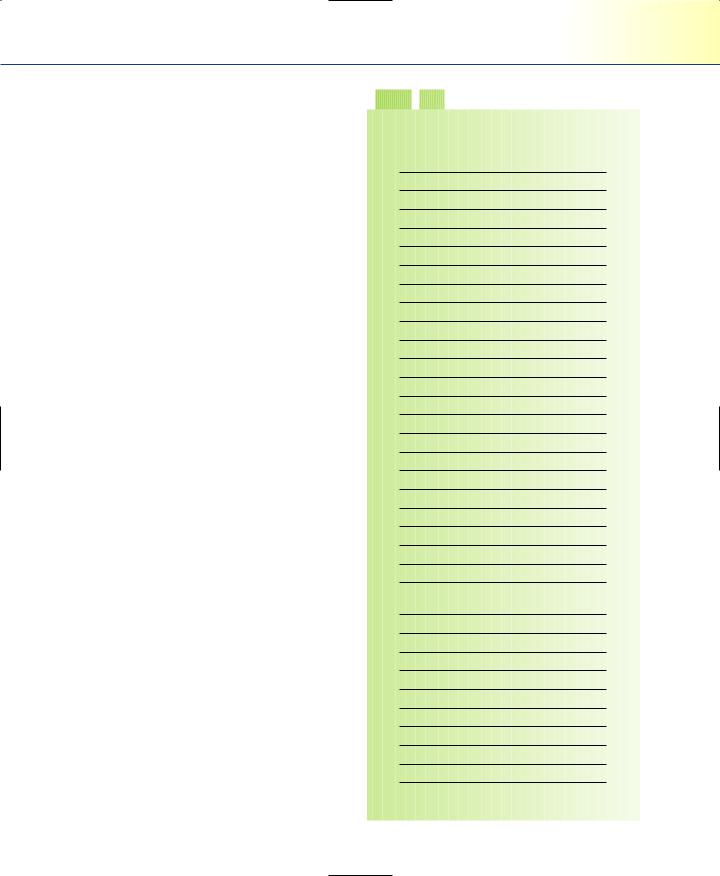
- •CONTENTS
- •PREFACE
- •Content—Benefits for Students
- •Content—Benefits for Instructors
- •Features of the Book for Students and Instructors
- •Supplementary Materials
- •Acknowledgments
- •What Is Hospitality Management?
- •The Manager’s Role in the Hospitality Industry
- •Why Study in a Hospitality Management Program?
- •Planning a Career
- •Employment as an Important Part of Your Education
- •Getting a Job
- •Employment at Graduation
- •The Outlook for Hospitality
- •Summary
- •Managing Change
- •Demand
- •Supply
- •Workforce Diversity
- •The Impact of Labor Scarcity
- •Summary
- •The Varied Field of Food Service
- •The Restaurant Business
- •The Dining Market and the Eating Market
- •Contemporary Popular-Priced Restaurants
- •Restaurants as Part of a Larger Business
- •Summary
- •Restaurant Operations
- •Making a Profit in Food Service Operations
- •Life in the Restaurant Business
- •Summary
- •Chain Restaurant Systems
- •Independent Restaurants
- •Franchised Restaurants
- •Summary
- •Competitive Conditions in Food Service
- •The Marketing Mix
- •Competition with Other Industries
- •Summary
- •Self-Operated Facilities
- •Managed-Services Companies
- •Business and Industry Food Service
- •College and University Food Service
- •Health Care Food Service
- •School and Community Food Service
- •Other Segments
- •Vending
- •Summary
- •Consumer Concerns
- •Food Service and the Environment
- •Technology
- •Summary
- •The Evolution of Lodging
- •Classifications of Hotel Properties
- •Types of Travelers
- •Anticipating Guest Needs in Providing Hospitality Service
- •Service, Service, Service
- •Summary
- •Major Functional Departments
- •The Rooms Side of the House
- •Hotel Food and Beverage Operations
- •Staff and Support Departments
- •Income and Expense Patterns and Control
- •Entry Ports and Careers
- •Summary
- •The Economics of the Hotel Business
- •Dimensions of the Hotel Investment Decision
- •Summary
- •The Conditions of Competition
- •The Marketing Mix in Lodging
- •Product in a Segmented Market
- •Price and Pricing Tactics
- •Place—and Places
- •Promotion: Marketing Communication
- •Summary
- •The Importance of Tourism
- •Travel Trends
- •The Economic Significance of Tourism
- •The United States as an International Tourist Attraction
- •Businesses Serving the Traveler
- •Noneconomic Effects of Tourism
- •Summary
- •Motives and Destinations
- •Mass-Market Tourism
- •Planned Play Environments
- •Casinos and Gaming
- •Urban Entertainment Centers
- •Temporary Attractions: Fairs and Festivals
- •Natural Environments
- •On a Lighter Note. . .
- •Summary
- •Management and Supervision
- •The Economizing Society
- •The Managerial Revolution
- •Management: A Dynamic Force in a Changing Industry
- •What Is Management?
- •Summary
- •Why Study Planning?
- •Planning in Organizations
- •Goal Setting
- •Planning in Operations
- •The Individual Worker as Planner
- •Long-Range Planning Tools
- •Summary
- •Authority: The Cement of Organizations
- •Departmentalization
- •Line and Staff
- •Issues in Organizing
- •Summary
- •Issues in Human-Resources Management
- •Fitting People to Jobs
- •Recruiting
- •Selection and Employment
- •Training
- •Retaining Employees
- •Staff Planning
- •Summary
- •The Importance of Control
- •Control and the “Cybernetic Loop”
- •Tools for Control
- •Summary
- •Leadership as Viewed by Social Scientists
- •Why People Follow
- •Leadership Theories
- •Communication
- •The Elements of Leading and Directing
- •Developing Your Own Leadership Style
- •Summary
- •A Study of Service
- •Rendering Personal Service
- •Managing the Service Transaction
- •How Companies Organize for Service
- •Summary
- •INDEX

Tools for Control |
613 |
CHARACTERISTICS OF CONTROL SYSTEMS
We can conclude our discussion of control systems by identifying four of their com-
mon characteristics:
1.Control systems are continuous. Data are collected and stored on a continuing basis so that if something goes wrong, the data can be carefully analyzed to direct management’s corrective action.
2.Reports must be timely. Data must be collected and reported so that management can act to correct a problem before there is too great a loss. Thus, many food service operators compute their food costs weekly or every ten days, rather than monthly, in order to catch and correct promptly any unfavorable food cost patterns that develop.
3.Control is aimed at some key point, and no action is called for unless a problem is detected. This approach is sometimes called management by exception. Thus, a food cost is computed periodically because it is a key cost in a food service operation. If the food cost is out of line, further study and action will be initiated. If no problem is detected in the routine report, no action will be taken.
4.Control is action-oriented. At the risk of belaboring this point, we repeat that nothing really is controlled until somebody does something about the problem. Thus, control systems and information systems are similar, but a control system not only includes the information but also provides for corrective action if it is required.
With profit margins as slim as they can be in the hospitality industry, particularly in food service, it is imperative to develop and maintain a workable control system. It is no coincidence that the companies that are leaders in hospitality do a particularly effective job of control. One company, Essex Partners, was highlighted in a recent issue of the Cornell Quarterly focusing on best practices. Essex follows three simple steps to achieve their control objectives: (1) they hire managers who are aware of the importance of control, they tie rewards to performance, and they provide adequate support in this area; (2) they prepare a carefully developed budget with input from various sources; and (3) they hold weekly meetings to review progress, focusing on controlling costs that include costs not typically considered a direct management responsibility.1
Tools for Control
Managers use two somewhat different kinds of tools to achieve control: financial accounting and managerial accounting. Although each form of ac-
counting has significant similarities, each is designed to meet particular needs.

614 |
Chapter 19 Control in Hospitality Management |
FINANCIAL ACCOUNTING
Students will recognize financial accounting as the subject routinely taught in their first college accounting course. Financial accounting is based on a series of conventions adopted by the accounting profession to ensure a common basis of reporting the results of business operations. Financial accounting is principally designed for outsiders: for bankers who may be asked to lend money or for stockholders or potential investors who want to evaluate the firm’s performance in comparison with other investments.
The principal financial reports used in financial accounting are the balance sheet and the statement of income and expense. The balance sheet is simply a statement of the firm’s value and ownership. On one side, it lists the firm’s assets, and on the other, the claims against those assets by those to whom the firm owes money and by the owners. Table 19.1 provides an example of a hospitality industry balance sheet. The balance sheet offers a great deal of information to financial analysts, but its use in day-to-day operations is limited.
The statement of income and expenses, on the other hand, is used by operations people both to evaluate performance on a month-to-month basis and, as we shall see, to prepare budgets for future periods.
Each segment of the hospitality industry has a uniform system of accounts that tells accountants how to classify the various kinds of income and expenses. The uniform systems of accounts serve two purposes. First, they present income and cost information so that results in one operation can be compared to those in other operations or with industry averages. Second, uniform systems of accounts collect information in a way that pinpoints performance against responsibility. In a restaurant, the chef or food production manager is responsible for the food cost; the people responsible for certain groups of workers (cooks, wait staff, dishwashers) are responsible for their component of payroll cost; and the restaurant manager is responsible for the restaurant’s overall operating performance. The accounting profession has developed the term responsibility accounting to describe this means of classifying and reporting financial information. This form of accounting is not, however, new to the hospitality industry. The hotel industry (with its own uniform system of accounts) has long pioneered responsibility accounting.
Income and expenses are divided among departments—in hotels, these departments include rooms, food and beverage, and telephone—and a departmental net income is derived by subtracting the departments’ expenses from the revenue it generates. Each departmental net income represents an accurate reflection of the department head’s performance. The general manager’s performance is assessed by total income before fixed charges, which is the total of all departments’ net operating incomes less certain unallocated expense items.

Tools for Control |
615 |
Just as the American Hotel & Lodging Association periodically updates and publishes a uniform system of accounts for hotels, the National Restaurant Association publishes a uniform system of accounts for restaurants. The American Hospital Association supplies similar guidance in health care, and the Food and Nutrition Service publishes guidelines for school lunch accounting.
One major purpose served by following the appropriate industry accounting system is that it permits your operation to compare its results with industry averages. For the hotel-motel industry, the accounting firm of PKF publishes an extensive study of hotel industry performance based on the uniform system of accounts. The National Restaurant Association publishes a statistical study for restaurants called Restaurant Industry Operations Report. Other organizations and associations publish similar reports for other segments of the hospitality industry.
MANAGERIAL ACCOUNTING
Financial accounting is prepared according to accounting conventions that enable outsiders to evaluate performance. Financial accounting statements, particularly the statement of income and expenses, are useful to managers as


 TABLE
TABLE
 19.1
19.1

















































Travel-On Motel Balance Sheet
as of December 31, 200X
Assets |
|
Current assets |
|
Cash |
$10,000 |
Accounts receivable |
15,000 |
Inventories |
12,000 |
- |
|
|
$37,000 |
Fixed assets |
|
Building |
$1,000,000 |
Less depreciation |
250,000 |
- |
|
|
750,000 |
Furniture and fixtures |
$110,000 |
Less depreciation |
55,000 |
- |
|
|
55,000 |
- |
|
TOTAL ASSETS |
|
- |
|
Liabilities and Capital |
|
Current liabilities |
|
Accounts payable |
$15,000 |
Accrued expenses |
7,000 |
Mortgage payable |
|
(within one year) |
10,000 |
- |
|
Long-term liabilities |
$32,000 |
Mortgage |
600,000 |
Capital |
|
Common stock |
$100,000 |
Retained earnings |
110,000 |
- |
|
|
210,000 |
- |
|
TOTAL LIABILITIES AND |
|
CAPITAL |
$842,000 |

616Chapter 19 Control in Hospitality Management
well as to outsiders, we should note, but they must always follow the conventional form prescribed by the accounting profession. Managerial accounting, on the other hand, is prepared by and for insiders, that is, management. For that reason, it can take any form that is helpful to managers. The principal concerns of managerial accounting in the hospitality industry are food and beverage cost control and payroll control. Some operators pay fairly close attention to such miscellaneous direct operating costs as cleaning and guest supplies as well as utilities, but much less time and effort are generally spent on these. The information these control systems yield, in turn, is used in the budgeting process.
Food and Beverage Cost Control. Food and beverage cost control can be divided, in turn, into two general areas: precost control and postcost control. Precosting refers to the process of determining in advance the cost of a portion of food or drink (or of a whole meal). This represents the “standard” cost. The best way to do this is to work from standard recipes and determine the cost of the recipe ingredients. Then, if standard portions are used, the recipe cost can be divided by the yield to determine the cost per portion. The cost developed in this process becomes an important selling price determinant. Once (1) the cost, (2) the selling price, and (3) the quantity of each item sold are known, an operator can predict food or beverage cost with reasonable accuracy—if nothing goes wrong.
Postcost control, sometimes called historical control, focuses on what has happened so that if something does go wrong, management will know about it at the earliest possible moment and will have the information necessary to find out specifically what did go wrong. The purpose of postcost control, then, is not so much to remedy errors that have already taken place but, as we noted earlier, to provide a basis for steps to prevent the same mistake from being repeated.
Payroll Control. Our discussion in Chapter 18 showed that the principal technique for controlling payroll costs is staff planning that includes a tight, analytical scheduling process to ensure adequate coverage for each station and to avoid wasted coverage. Scheduling may be likened to precost control. For each payroll period, the payroll cost (i.e., the ratio of payroll cost to sales) is computed and compared with the target that management has established for that cost. When costs are out of line, management can institute special reporting systems for overtime hours (hours in excess of 40, for which time and a half must generally be paid) and for “extra” hours (hours in excess of those budgeted for the period).
Specialized Controls. Some operations develop specialized controls, or special reporting procedures, to control other direct operating costs such as cleaning supplies.

Tools for Control |
617 |
These procedures generally take the form of issuing systems that permit management to monitor closely the use of supplies such as soap, cleanser, and paper towels.
Some restaurants control china, glass, and silver breakage costs by taking a periodic inventory to determine the number of pieces broken or lost. This figure is then related to sales in a ratio called “the number of guests per broken piece.” This kind of information can be tabulated simply by noting breakage as it happens. If management notes who broke each piece (usually by sorting the broken pieces into bins for each worker group), it becomes possible to categorize daily breakage by worker group. Management can then focus attention on those who are most responsible for the breakage.
Budgeting. The process of operating the controls described here yields a great deal of information about the business patterns that can be expected in the future. A budget is basically a plan of action spelled out in dollars, and it is usually based on information provided by the management accounting systems. Sales for some future period are estimated; then, applying the percentage for each expected cost (food cost, payroll cost, supplies cost, and the like), management can prepare an expense budget. Because cost patterns change, expense budgets may be based in part on past experience and in part on expected future cost trends.
The procedure for preparing budgets in many hospitality operations, especially at the unit level, need not be especially complicated. On a copy of a current or recent statement of income and expenses, write the estimate for the budget period alongside the figures for the past period. Base the new figures on experience and expected future trends (as shown in Table 19.2). These estimates may then be formalized after discussion with key department heads.
In multiunit companies, budgets are sometimes drawn up at the company’s headquarters using computerized records of past performance and are then “rolled down” to the district and unit levels. At that point, the process reverses itself, with the units forwarding the revised unit budgets to the district level. Once approved at that level, the district totals its unit budgets and sends them to the control office as the district budget. As you can imagine, this process often involves a good deal of negotiation among the different levels of a multiunit firm.
Whereas business firms base their budgets on sales, public-sector food service operators (such as school lunch programs) must use appropriations as a basis for starting the budget process. Thus, for school lunch, the local school board may supply some operating funds; the state is another source of funding; and the federal government supplies a certain amount for each lunch served, and an additional amount for each free and reduced-price lunch. Finally, most students pay a certain amount for each meal. The income portion of the budget is basically a reflection of the number of meals served (student payments and the federal subsidy) and, thus, is similar to the

618 |
Chapter 19 Control in Hospitality Management |

 TABLE 19.2
TABLE 19.2

























































Mid-Town Restaurant Statement of Income and Expense, Year Ending
December 31, 200X
Sales |
$ |
$ |
|
Food |
747,251 |
77.0 |
848,000 |
Beverage |
226,507 |
23.0 |
252,700 |
Total |
983,758 |
100.0 |
1,100,700 |
Cost of Sales |
|
|
|
Food |
326,375 |
43.1 |
356,100 |
Beverage |
61,116 |
27.0 |
66,000 |
Total |
387,491 |
39.4 |
422,100 |
Gross Profit |
596,267 |
60.6 |
678,600 |
Other Income |
14,759 |
1.5 |
66,000 |
Total Income |
611,023 |
62.1 |
744,600 |
Controllable Expenses |
|
|
|
Payroll |
252,286 |
25.6 |
290,600 |
Employee Benefits |
46,237 |
4.7 |
53,900 |
Direct Operating Expenses |
54,107 |
5.5 |
60,500 |
Music and Entertainment |
5,902 |
.6 |
6,600 |
Advertising and Promotion |
15,740 |
1.6 |
17,600 |
Utilities |
20,659 |
2.1 |
23,100 |
Administrative and General |
59,025 |
6.0 |
66,000 |
Repairs and Maintenance |
16,724 |
1.7 |
18,700 |
Total |
470,680 |
47.8 |
537,000 |
Income Before Occupation Costs |
140,343 |
14.3 |
207,600 |
Occupation Costs |
|
|
|
Rent, Property Taxes, and Insurance |
45,253 |
4.6 |
48,000 |
Interest |
5,998 |
.6 |
5,000 |
Depreciation |
19,651 |
2.0 |
19,600 |
Total |
70,902 |
7.2 |
72,600 |
Net Income Before Other Deductions |
69,441 |
7.1 |
135,000 |
Other Deductions |
4,918 |
.5 |
5,000 |
Net Income Before Taxes |
64,523 |
6.6 |
130,000 |
sales item in a commercial operation. In some cases, additional sources of revenue may also be identified.
In health care, sales (except in the pay cafeteria) are not the determining figure for budgeting. That figure is, rather, some budgeted amount based on (1) the number of patient days expected and (2) the budgeted cost per patient day for food service.

Tools for Control |
619 |
Although sales, as such, are not the key, the starting point in the budget is the number of physical units (i.e., meals) that management expects will be consumed—a concept fundamentally quite similar to the sales estimate of a commercial operation.
Expense items in nonprofits’ budgets are prepared in much the same way as in the commercial sector—that is, they are based on past experience and adjusted for expected change. In some cases, the expenses themselves are different. For instance, public institutions may receive commodities donated by the federal government. These donations change the cost of some items, but the budgeting procedure remains basically the same.
A budget should be the basis for management’s cybernetic action: Actual results are compared with budgeted results, variances from budget target are analyzed to determine causes, and corrective action is initiated.
DECISION ACCOUNTING
Both financial accounting and management accounting are basically cyclical and repetitive. Budgets, for instance, can be prepared monthly, quarterly, and annually. As a month elapses, statements of results are reflected on accounting statements and compared with the budget. Then the whole cycle begins again the next month.
Financial accounting statements, moreover, embody the conventions accepted by the accounting profession. For instance, when an asset is acquired, a useful life for that kind of an asset is assumed, and the cost of the item is written off by means of an accounting entry reflecting its depreciation. Thus, a motor hotel valued at $1 million with a 20-year useful life will charge $50,000 a year to depreciation on its accounting statements. At the end of five years, following accounting conventions, the motor hotel will be valued at $750,000. Quite clearly, these conventions are convenient and permit standard treatment (or one of several standard treatments) to be applied in a way that helps make the resulting accounting statement understandable to insiders and outsiders alike. However, although accounting conventions are necessary, they often distort what is really happening. For instance, if the motel just described has been bypassed by an expressway, its value may have dropped far more than the depreciation entry indicates; by contrast, if a new office park has been built across the street, the motel’s value may have doubled instead of depreciated.
Decision accounting, which is often related to strategic planning, differs from financial and management accounting in that it is not cyclical. The information for a decision is assembled in numerical form on a one-time basis.
Also, the conventions of accounting play no part in decision accounting. The assumptions made are those deemed appropriate to the analysis of the particular decision at hand. For instance, decision accounting tends to focus on direct variable costs such as food cost and payroll. It tends to ignore bookkeeping entries such as depreciation. Some examples of decision accounting tools—the payback period, rate of return, and break-even point computation—were presented in Chapter 16.
